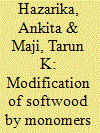|
|
|
Sort Order |
|
|
|
Items / Page
|
|
|
|
|
|
|
| Srl | Item |
| 1 |
ID:
130743


|
|
|
|
|
| Publication |
2014.
|
| Summary/Abstract |
In this paper, we report the embedment of Cobalt (Co) nanoparticles by ion beam sputtering (IBS) in poly(vinylalcohol) (PVA) substrate to prepare nano composite film. The Co film of 5 nm was deposited on PVA by IBStechnique. Formation of Nano crystalline Co with HCP phase is revealed in GIXRD pattern of the film which alsoindicates that there is no change in the crystalline structure of PVA even after sputtering of the metallic nanoparticles.The average particle size of Co nanoparticles as evaluated using Scherer formula is found to be about 2 nm. UVVisabsorption spectrum of the film showed SPR peaks of Co metal in their nano size level embedded in the PVAmatrix system. XPS study confirms the metallic nature of Co MOKE studies show that the nanocomposite film isferromagnetic with HcÐÐ of. 42.8 Oe.
|
|
|
|
|
|
|
|
|
|
|
|
|
|
|
|
| 2 |
ID:
130735


|
|
|
|
|
| Publication |
2014.
|
| Summary/Abstract |
Technological development of wood polymer composites (WPC) is a very promising approach to overcome most of the disadvantageous properties of wood products, for example their poor mechanical strength, poor dimensional stability, susceptibility to fungal attack, weathering and the like. To find the substitute for costly items of hard wood, suitable technologies have been developed to modify softwood to meet specific end-use requirements. Various vinyl monomers and/or copolymers or thermosetting resin in combination with different types of cross linking agents, flame retarding agents have been used to improve the properties of wood. Nanotechnology is a new area of science and technology which opens up new opportunities to develop wood based products with desired properties. Now-a-days government is making strict legislations to promote green technology for the protection of environment world wide. With the depletion of petroleum resources at alarming rate, it is high time to replace petroleum-based products by some sustainable alternative products based on vegetable biomass. The bio-based resins obtained from renewable feedstock have been widely utilized by taking the advantages of easy availability, renewable nature and low cost. The green route of modification of wood is widely encouraged. With the progress of technological development, now it is possible to avoid the hazardous influence of organic solvents by using water as solvent or diluents formodification of wood. WPC has got tremendous scope for use in diverse areas of applications.
|
|
|
|
|
|
|
|
|
|
|
|
|
|
|
|
| 3 |
ID:
138628


|
|
Preparation and properties of 1, 3, 5, 7-Tetranitro-1, 3, 5, 7-Tetrazocane-based nanocomposites
/ Shi, Xiaofeng; Wang, Jingyu ; Li, Xiaodong ; Ji, Wei
|

|
|
|
|
| Summary/Abstract |
A new insensitive explosive based on octahydro-1, 3, 5, 7-tetranitro-1, 3, 5, 7-tetrazocine (HMX) was prepared by spray drying using Viton A as a binder. The HMX sample without binder (HMX-1) was obtained by the same spray drying process also. The samples were characterised by Scanning Electron Microscope, and X-ray diffraction. The Differential Scanning Calorimetry and the impact sensitivity of HMX-1 and nanocomposites were also being tested. The nanocomposite morphology was found to be microspherical (1 μm to 7 μm diameter) and composed of many tiny particles, 100 nm to 200 nm in size. The crystal type of HMX-1 and HMX/Viton A agrees with raw HMX. The activation energy of raw HMX, HMX-1 and HMX/Viton A is 523.16 kJ mol-1, 435.74 kJ mol-1 and 482.72 kJ mol-1, respectively. The self-ignition temperatures of raw HMX, HMX-1 and HMX/Viton A is 279.01 °C, 277.63 °C, and 279.34 °C, respectively. The impact sensitivity order of samples is HMX/Viton A < HMX-1 < raw HMX from low to high.
|
|
|
|
|
|
|
|
|
|
|
|
|
|
|
|
| 4 |
ID:
138630


|
|
Preparation and properties of 1, 3, 5, 7-Tetranitro-1, 3, 5, 7-Tetrazocane-based nanocomposites
/ Shi, Xiaofeng; Wang, Jingyu ; Li, Xiaodong ; Ji, Wei
|

|
|
|
|
| Summary/Abstract |
A new insensitive explosive based on octahydro-1, 3, 5, 7-tetranitro-1, 3, 5, 7-tetrazocine (HMX) was prepared by spray drying using Viton A as a binder. The HMX sample without binder (HMX-1) was obtained by the same spray drying process also. The samples were characterised by Scanning Electron Microscope, and X-ray diffraction. The Differential Scanning Calorimetry and the impact sensitivity of HMX-1 and nanocomposites were also being tested. The nanocomposite morphology was found to be microspherical (1 μm to 7 μm diameter) and composed of many tiny particles, 100 nm to 200 nm in size. The crystal type of HMX-1 and HMX/Viton A agrees with raw HMX. The activation energy of raw HMX, HMX-1 and HMX/Viton A is 523.16 kJ mol-1, 435.74 kJ mol-1 and 482.72 kJ mol-1, respectively. The self-ignition temperatures of raw HMX, HMX-1 and HMX/Viton A is 279.01 °C, 277.63 °C, and 279.34 °C, respectively. The impact sensitivity order of samples is HMX/Viton A < HMX-1 < raw HMX from low to high.
|
|
|
|
|
|
|
|
|
|
|
|
|
|
|
|
|
|
|
|
|